Not all card changes are the same: for every adjustment that takes the power level of an oppressive minion down a notch, there are many that completely pulverize the card, making sure it will never see serious play again. The latest patch featured examples of both, but even victims like Corridor Creeper would likely understand that their fate is nowhere near the worst that has been suffered by cards that were whacked with the nerf bat over the years.
The Hall of Fame & The Misconceptions of Power Creep
There are two wide categories of nerfs: sometimes a card gets adjusted because it enables an overly powerful or frustrating deck, and otherwise it’s hit because it is too strong in its slot for whatever reason, seeing play all across the board. The latter is the kind of change that is rarely called for by the community, and it’s usually Team 5 that occasionally throws the unexpected punch at cards like Fiery War Axe for reasons that remain semi-mysterious even long after the fact, making terms like “design space” into a meme in the wider community. 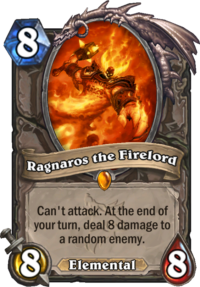
Lately, the introduction of the Hall of Fame has allowed the developers to just rotate the problematic cards into Wild where the power levels are much higher, likely sparing Azure Drake and Ragnaros the Firelord from a crippling nerf, but not everyone was so fortunate back in the day. The April 2016 patch has gutted many staples in preparation for the arrival of Standard – and the class that was hit the hardest of them all was clearly Druid. Its 14-damage two-card combo only required Classic cards, and the evergreen options for Malfurion were so powerful that most of its cards in the later set had to be purposefully kneecapped to keep that powerful mid-range deck in check.
In the end, Force of Nature’s Treants lost their Charge, a massive nerf for which a cost reduction and an added permanency could never make up. Keeper of the Grove was simply deemed too good for its price: doubling as either a sort of Fire Plume Phoenix or a slightly weaker Spellbreaker was extremely flexible and it was purposefully nuked into unplayability to solve that problem. In retrospect, the nerf to Ancient of Lore seems a bit weird seeing how the same people willingly printed Ultimate Infestation for the same class a few years later, but it’s worth mentioning that the card actually found a home in aggro decks as well, making it genuinely omnipresent in every Druid archetype. Their nerfs meant that the new cards were more likely to flourish in Standard – and that, more importantly, Team 5 wouldn’t have to print even better cards in order to change the way Malfurion plays over time.
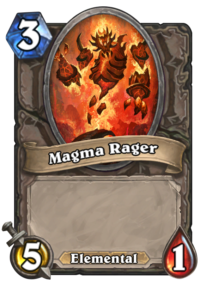
It’s also worth mentioning that there’s a widespread misconception regarding power creep – namely that a card like Ice Rager has “power crept” Magma Rager because it is strictly better. In fact, that isn’t the case because the latter has never actually seen play to begin with, meaning the arrival of the 5/2 for 3 mana hasn’t actually impacted the power levels in the metagame. On the other hand, something like Piloted Shredder has certainly power-crept the neutral 4-drop slot, greatly increasing the standard by which other prospective options are judged. Changes like the ones listed above are made to combat this phenomenon, lowering the barrier of entry in the case of certain slots by taking a hammer to the most popular option available to the players – of course, it’s a reasonable question to ask why Magma Rager didn’t get a buff instead of an identical card being printed, but that’s a discussion for another time.
Many other staple cards were lost around that time: the original Blade Flurry is still mourned by Rogue players, while the nerf to Molten Giant is one of those that still doesn’t make any sense, not even close to two years and almost two Standard rotations after the fact.
Overly Powerful Cards
If the nerfs above were generally met with confusion, the following ones were mostly greeted by a collective sigh of relief. There were quite a few cards – and corresponding decks – that were either too powerful or just unfun to play against, and Team 5’s response to these archetypes have always been quite predictable: initial silence followed up by hate-cards in the next set (that almost never actually worked in the way they were intended to), then an eventual overkill nerf making sure that such a situation doesn’t ever arise again.
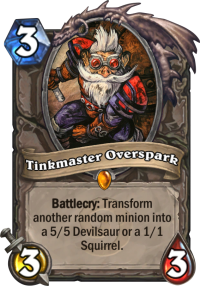
It’s worth mentioning that the developers were – perhaps understandably – a lot more diligent about card adjustments in the beta period, responding faster to concerningly swingy cards. Nat Pagle – who used to draw a card at the end of your turn – was sometimes single-handedly responsible for winning the value battle, which was especially excruciating when both players’ fishermen stuck on the board but only one of them actually got the catch. The other problematic card around that time was Tinkmaster Overspark, whose transformation ability could target any minion, which meant that hitting a premium target would be very beneficial even if you rolled a 5/5 Devilsaur off of it. It’s quite interesting to see how the tolerance levels regarding RNG have changed over time – just like how the aforementioned, overly slow card adjustment protocol has only become commonplace after the release of the first adventure of the game.
Speaking of which, The Curse of Naxxramas featured many cards that greatly increased the power levels in the game, but perhaps none of them were as crazy as the fabled Undertaker, also known as the 1-mana Yeti in some circles. Originally it gained +1/+1 per Deathrattle minion instead of just the extra Attack, making it incredibly easy to snowball an early lead out of control with a humongous 1-drop behind it all.
Even though the problem was clear very early on – with both prominent Warlock and Hunter decks featuring the related package alongside a Priest deck built around Dark Cultist and Deathlord –, Team 5 neglected to change the card for over three months until the release of the following set, Goblins versus Gnomes, which featured two useless counter-cards in the form of Lil' Exorcist and the Paladin-exclusive Scarlet Purifier. Eventually, they brought out their dead and killed the card for good, removing its health gain – though interestingly enough, it wasn’t necessarily meant to be a complete obliteration, at least according to the patch notes, which stated that “with this change, we expect Undertaker will still be better than other 1-Mana minions when played in a deck with a Deathrattle theme, but more likely to die in combat against other minions”, a scenario that has never really come through.
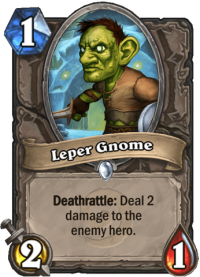
In terms of raw stat changes, the nerfs to 1-drops are the harshest by necessity. Leper Gnome and Abusive Sergeant were both omnipresent in aggressive decks, both of which were essentially destroyed by the removal of their second attack stat: such cheap cards have continued to be a problem later on as well, with both Small-Time Buccaneer and eventually Patches the Pirate getting kneecapped later down the line, the latter completely losing its identity in the process – so much so that even his voice line had to be changed. It’s worth mentioning that the hate cards printed in the game so far have basically never managed to fill their intended role – Loatheb has been co-opted by Miracle Rogue, Skulking Geist had no effect on Jade Druid, Golakka Crawler hasn’t stopped Patches at all, while cards like Streetwise Investigator and Dragonslayer have never seen play –, meaning the developers always seem to always have to resort to nerfs in order to force a serious metagame shift.
Roughest Nerfs
Which, of course, leads us to one of the roughest adjustments of them all – Warsong Commander was the one caught in the fire as the authorities tried to put an end to Grim Patron’s rampage, the second time that particular card has been adjusted – initially to stop free Molten Giants from charging out in an old OTK Warrior deck, and this time the developers made sure that minions without the corresponding keyword will never get to attack immediately again. It remained a 2/3 for 3 in all of its incarnations, but its ability was slowly but surely obliterated, its final version to date – granting +1 attack to friendly minions with Charge – being absolutely useless, but opening up a lot of design space. Eventually, even the spell giving Charge had to be changed because of a deck revolving around Raging Worgen, something which could have easily gotten out of hand with the otherwise useless hand-buff cards.
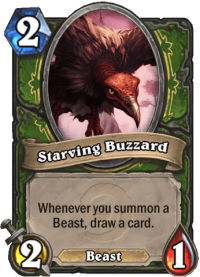
Still, even this change doesn’t even hold a candle to what was perhaps the harshest nerf in the history of the game, a change that was so ridiculous one has to wonder why they haven’t simply deleted the card instead: Starving Buzzard, after a bunch of minor adjustments, has eventually been whacked by a flat 3-mana cost increase without any text change, making sure it will never be able to efficiently combine with Unleash the Hounds again. Predictably, the card has not seen play ever since, apart from unlucky Firelands Portal-rolls and sad Arena drafts – which just goes to show that if a card is completely destroyed by a nerf, it might as well be removed from the game or sent over to Wild instead, seeing how their continued presence in Standard only serves to frustrate those unfortunate enough to still encounter them somewhere.

Almost all of these provided interesting meta shifts though. It’s nice to figure out the meta after it happens, just seems sometimes that there isn’t enough playtesting from their part. They’d spot most of these cards way earlier!
We Rogues miss u, conceal </3
Hard to fully appreciate the nerfs without being able to see all of the pre-nerf states of all the cards you mention.
Old players know !! 🙂
The Hearth Remembers